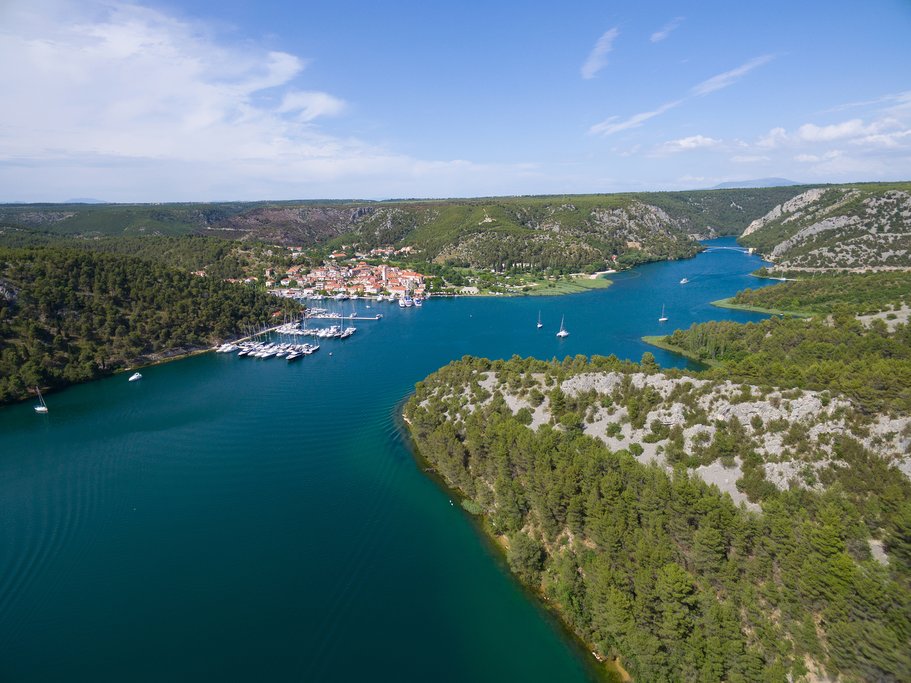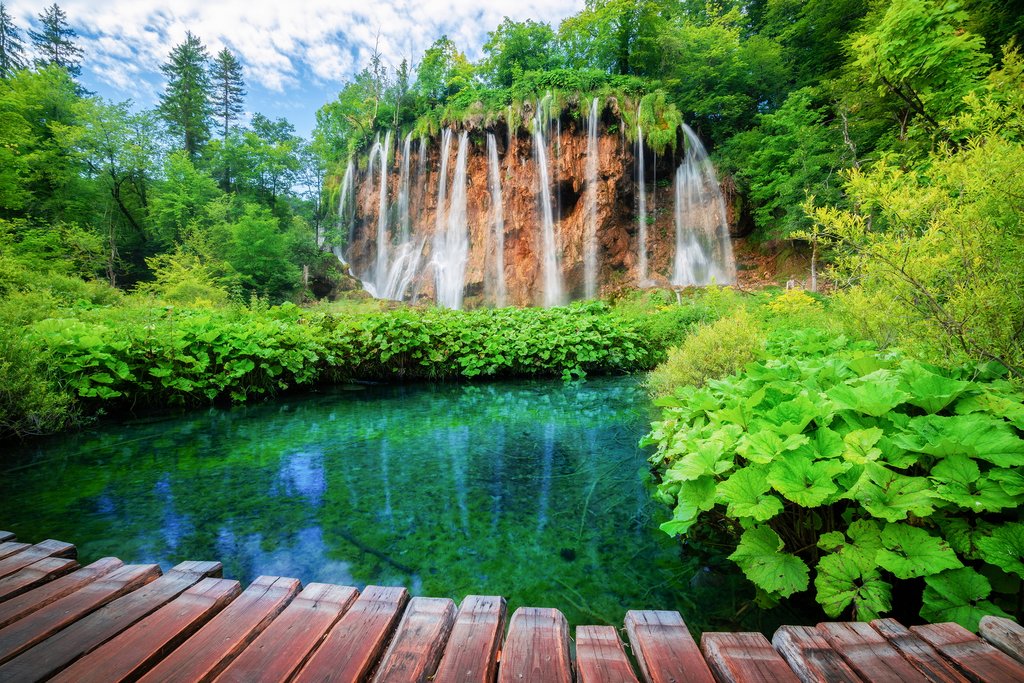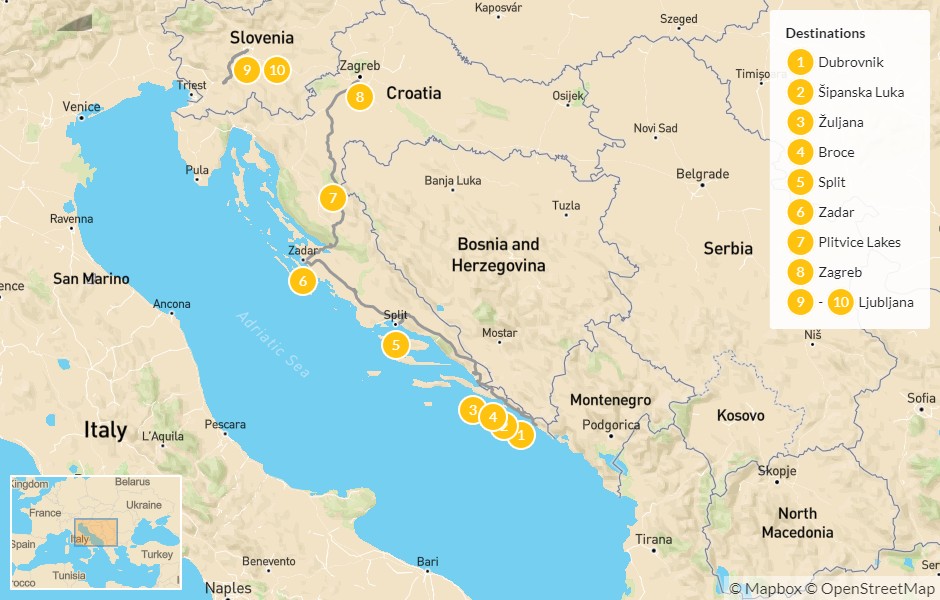Highlights
- Hoist anchor and sail amid the Elafiti Islands of Koločep and Šipan
- Enjoy views over the Adriatic and historic saltpans from a parapet walkway in Ston
- Admire the captivating beauty of Skradin and its surrounds on an e-bike tour
- Watch Zadar's Monument to the Sun's colorful displays of light
- Row a boat to Bled's fairytale chapel in the center of its namesake lake
Brief Itinerary
| Day | Highlights | Overnight |
|---|---|---|
| Day 1 | Welcome to Dubrovnik! | Dubrovnik |
| Day 2 | Sail from Dubrovnik to Šipan, Stopping at Koločep | Šipanska Luka |
| Day 3 | Sail from Šipan to Žuljana, Stopping at Mljet National Park | Žuljana |
| Day 4 | Swim, Snorkel, Sail, and Bike the Pelješac Peninsula | Broce |
| Day 5 | Sail from Broce to Komolac, Onward to Split | Split |
| Day 6 | Split to Zadar, E-Bike Tour & Krka National Park | Zadar |
| Day 7 | Zadar to Plitvice Lakes National Park | Plitvice Lakes |
| Day 8 | Sunrise at Plitvice Lakes, Transfer to Zagreb | Zagreb |
| Day 9 | Zagreb to Lake Bled, Walking City Tour of Ljubljana | Ljubljana |
| Day 10 | Postojna Cave and Predjama Castle (Day Trip from Ljubljana) | Ljubljana |
| Day 11 | Depart Ljubljana |
Detailed Itinerary
Day 1: Welcome to Dubrovnik!

Welcome to the "Pearl of the Adriatic." Upon arrival at the airport, you'll transfer to your hotel for check-in. Despite being tired from the journey, you'll likely want to get out and explore. Can't-miss activities include riding the cable car up to Srđ Mountain to take in the sunset over the nearby Elafiti Islands, visiting Lovrijenac and Bokar fortresses, and walking along the smooth, limestone-paved streets of historic Old Town.
A piece of history, Dubrovnik is one of the most ancient fortress cities in Europe. And while there's evidence of settlements as far back as the Byzantine era, this area only came into its own as an important power since the 13th century due in part to its strategic coastal position. Dubrovnik's long and storied history is told in its beautiful Gothic, Renaissance, and baroque churches, monasteries, palaces, and fountains all found within its imposing fortress walls.
After spending some time getting to know the city, duck into one of Dubrovnik's many wine bars to relax. It's a good plan, as there's no better manner in which to celebrate your first day in Croatia than by enjoying a glass of white or red wine as the sun goes down over Dubrovnik's Old Town. For dinner, you can choose from a number of great restaurants.
Day 2: Sail from Dubrovnik to Šipan, Stopping at Koločep

This morning you'll transfer the short distance to the small port village of Komolac, the starting point of your sailing adventure. Here you will meet your skipper, board your private sailboat, and chart a course west toward Šipan, stopping first to visit one of the most beautiful islands in the Elafiti archipelago, Koločep (referred to by locals as "Kalamota"). The southernmost inhabited island in Croatia, you'll have the chance to try your skill at stand up paddleboarding as well as do a little snorkeling, followed by a delicious lunch next to the sandy beach.
You'll return to your sailboat and continue to Šipan, dropping anchor in the harbor of Šipanska Luka—a quaint fisherman's village located at the apex of a deep inlet. The largest of the Elafiti islands, Šipan was once home to Dubrovnik's patricians, but today remains a peaceful and well-preserved Dalmatian island: craggy hills along the coast, fertile land in the interior, and the occasional hamlet throughout.
Once on land, admire the enormous plane tree the settlement is grouped around before continuing to explore relics of Šipanska Luka's past and finding your way to a seaside tavern to enjoy a meal. And when you're ready, you'll return to the boat for your first night of falling asleep to the gentle sway of the waves.
Day 3: Sail from Šipan to Žuljana, Stopping at Mljet National Park

Pull up anchor this morning and carry on west to Mljet Island where you'll disembark to spend time exploring Mljet National Park. Enjoy the sea breeze and the day's sun as you relax and delight your senses with the sound of the waves and a chance sighting of dolphins (if luck is on your side). Considered the greenest as well as one of the larger Adriatic islands off the Croatian coast, Mljet is a thin strip of land parallel to the Pelješac peninsula where the smell of pine, juniper, and a number of aromatic herbs perfume the air.
The park itself covers a third of the island and is made up of lakes and bays, dense forests, and olive groves. You'll ride a bike to explore the park and stop to enjoy a swim in any of the beautiful lush coves. Popular sights worth a visit include Veliko and Malo Jezero (Large and Small Lake)—two salt lakes in the park. If the mood should strike, stop for a swim in the lakes (which are invariably warmer than the open Adriatic sea). There's also the option to join a guided tour through the park to visit a 12th-century Benedictine monastery, accessed only by boat.
After the sails are hoisted, you'll cruise toward the ruggedly beautiful Pelješac peninsula to overnight aboard the catamaran in the turquoise Žuljana Bay. One of the peninsula's most dramatically situated villages, you'll disembark for dinner and a little exploration before returning to your sleeping quarters.
Day 4: Swim, Snorkel, Sail, and Bike the Pelješac Peninsula

Today is reserved for a fun morning of stand up paddleboarding, swimming, and snorkeling in the sandy shallows of the sunning Žuljana bay before switching gears in the afternoon and venturing on land. You'll climb aboard your catamaran and sail east to the small village of Broce, passing by the steeply-perched vineyards on the peninsula's southern slopes along the way. Once in Broce, you'll come ashore to gear up and ride borrowed bikes to the medieval town of Ston.
Ston—and its twin village, Mali Ston—act as the gateway to the Pelješac peninsula, a rugged coastal landscape home to one of Croatia's best-known red wines, Dingač, and tasty oysters. Here, you can trek one of the longest defensive stone walls in Europe (originally built to keep predators away from the town's saltpans). Savor a meal of locally grown, fresh oysters or mussels after you climb part of the parapet walkway of Ston's wall for beautiful views over the town and its glittering saltpans—one of the oldest and still active in the Mediterranean!
Chat with a local specialist who can help organize your trip.
Day 5: Sail from Broce to Komolac, Onward to Split

In the morning, you'll set out early to make the return trip to Komolac, passing by the green Elafiti islands once again. Find your way to a restaurant to fuel up before making the transfer up the Dalmatian coast to Split. Once you have settled into your accommodation take the rest of the afternoon and evening to explore the ancient port city on your own.
Start at Pjaca Square for pretty views of white marble tiles, the Iron Gate (the western entrance to Diocletian's Palace), a Romanesque clock tower with the remains of a medieval sundial, and the 15th-century Town Hall. Stop for lunch at Trattoria Bajamont, just north of the Iron Gate. From there, visit the popular Voćni trg or Fruit Square. Here you can enjoy renaissance architecture, influenced during Split's Venetian era. For a bit of shopping and a bite to eat head to Marmont Street, though you'll want to make your way to the waterfront to catch the sunset.
In the evening, take a stroll along Split's seafront Riva to admire the views over the Adriatic before finding the off-beat Konoba Dioklecijan restaurant, just to the left of the Bronze Gate for dinner, its outdoor terrace built into the walls of famed Diocletian's Palace.
Day 6: Split to Zadar, E-Bike Tour & Krka National Park

Today, you'll spend time exploring the Adriatic coast as you make your way from Split up to Zadar. On your way, you'll break up the trip with a visit to Krka National Park, stopping first in Skradin. A romantic Mediterranean town with narrow cobbled streets, passages, arches, and stairs, it is best known as the gateway town to Krka National Park, though it's home to notable archaeological sites within the local vicinity. It is here you'll collect your electric bike (e-bike) to explore the captivating landscape of the area as you cover some ground on a fun tour.
After returning your bikes, you'll have time to visit Krka. With seven waterfalls—the largest and most impressive being Skradinski Buk—Krka National Park is home to a network of striking waterfalls. The Krka river, another highlight of the park, carves through the limestone and creates a spectacular canyon on its 44-mile journey (70 km) from the foothills of the Dinaric Alps to Šibenik.
You'll follow the well-marked winding wooden paths as you traverse emerald pools and river islands to prime lookout spots in which to view the falls. Skradinski Buk is the final of the seven waterfalls, and Mother Nature saved the best for last. Cascading 78 feet (24 m) down into an emerald lagoon wider than the falls are tall, you'll have time to admire the postcard-perfect locale before exiting the park and continuing your journey to Zadar.
A historical center of the Dalmatian Coast, Zadar is famous for its picturesque coastline full of islands and vibrant blue waters, as well as fresh seafood and unforgettable sunsets (Alfred Hitchcock is on record saying they're the best in Zadar). Take the rest of the day to relax and explore. Perhaps stroll along Zadar's Riva, a wide ribbon of stone paths that runs along Old Town’s waterfront, where it comes alive at night with vendors and Dalmatian a capella groups (Klapa) that serenade the passersby, including folks on yachts who dock there.
Day 7: Zadar to Plitvice Lakes National Park

After breakfast and packing up your belongings, you'll drive east to Plitvice Lakes National Park, the first Croatian national park—and one of the most popular parks in the country.
Plitvice Lakes National Park is Croatia’s natural masterpiece, gorgeous at any time of year. A must-visit for any traveler to Croatia, the UNESCO-protected park is comprised of an exquisite collection of 16 glassy emerald green and blue travertine lakes, more than 90 cascading waterfalls that seemingly cover every corner of the park, and numerous caves. Beech and pine forests surround the terraced lakes and are home to extensive wildlife.
Here, you can request a private, expert local guide to lead you throughout the park along the wooden paths and bridges to show you the most impressive points of interest and explain the significance of its history and natural features. After your tour, you will have some free time to continue exploring, or you may wish to bring a bought lunch (and a bottle of wine!) with you to enjoy a picnic.
Day 8: Sunrise at Plitvice Lakes, Transfer to Zagreb

Early morning is one of the best times to visit Plitvice Lakes before the mid-day crowds arrive. You can explore the park on your own or opt for a local guide who will take you on a number of defined routes of varying lengths throughout the park. After enjoying a leisurely morning in Plitvice, carry on your way north, venturing farther inland to Croatia's capital, Zagreb.
Settle into your hotel before venturing out to spend the rest of the day as you like. The city center is easily walkable and the streets and parks are easy to navigate by foot. All the main attractions and restaurants are within walking distance. A gem of a European city, Zagreb is at once historic and new. It's filled with leafy green parks and gothic/neo-renaissance buildings, yet there are also modern shopping complexes, outdoor malls, and endless dining and drinking options.
Consider heading out on a guided walking tour of the historic heart of the city. This involves walking from the main square to Zagreb's Upper Town and passing through local markets before reaching St. Mark's Square. Alternatively, you can visit one of the many museums and art galleries, like the Homeland War Museum, the Nikola Tesla Technical Museum, or the ever-popular Museum of Broken Relationships. Or stroll through the city center, enjoying 17th-century neo-baroque architecture found at Zagreb's Art Pavilion and Croatian National Theater.
Zagreb also has a number of beautiful city parks which are great for exploring and people watching, especially in the late afternoon. Maksimir is a great option, with a variety of cafés nearby to pick up a coffee for your stroll.
Day 9: Zagreb to Lake Bled, Walking City Tour of Ljubljana

This morning you will drive just over two hours west to cross the border into Slovenia to the fairytale shores of Lake Bled. This postcard-perfect lake with an island in the middle and surrounded by the soaring peaks of the Julian Alps is one of Slovenia's main attractions. If you're up for a hike, you can choose from a variety of trails through beautiful gorges or to scenic viewpoints. The craggy walkways and waterfalls of the popular Vintgar Gorge are just 2.5 miles (4 km) from town.
You can also climb up to Bled Castle and tour its smithy, wine cellar, and printing press before enjoying a traditional meal in the restaurant, or row or paddleboard across the placid waters of the lake. If you decide to go to the fairytale island at the lake's center, climb up the church's 99 steps, where legend has it the ringing of the bell can grant your wishes. Then, cycle your way through typical Slovenian countryside, or simply sunbathe on the lakeside with a slice of the famous Bled cream cake at the Park Hotel or Slascicarna Zima bakery.
In the afternoon, you'll circle back to Ljubljana to check into your accommodation. Once settled, you'll meet your guide for a tour of the dynamic capital. Explore the lively city center and saunter down the main street along the banks of the Ljubljanica River, stopping in whatever small boutique, outdoor café, or wine bar terrace strikes your fancy as you breathe in the fresh air of one of the continent's greenest cities.
A classic European castle, parks, and churches are all on offer as you wind your way around town by foot or bicycle. You'll notice the legacy of modern architect Jože Plečnik around the city at worthwhile stops such as the National Library, Central Market, Triple Bridge, and Plečnik's own home-turned-museum, all under the watchful eyes of the city's many signature dragons. The Central Market is also a key site for sampling local cuisine at its many stalls.
Day 10: Postojna Cave and Predjama Castle (Day Trip from Ljubljana)

Get an early start today to turn your attention to Slovenia's rugged and beautiful Karst region and make a point to visit the Postojna Cave. This cave is the largest show cave in Europe and is widely considered to be one of the most beautiful caves in the world. You'll get to ride the miniature electric train down the cave's long tunnel and take an hour-and-a-half-long guided tour, where you'll see and learn about the cave's unique karst topography—dangling stalactites and rising stalagmites.
On the tour, you'll be able to see the over 16-foot high (5 m) stalagmite known as Brilliant, visit the oldest underground post office in the world, and if luck is on your side, see the olm, a type of pale-bodied salamander endemic to the karst caves of Croatia and Slovenia.
Next, you'll head to the nearby Predjama Castle, a medieval castle built right into the mouth of a clifftop cave. Predjama is the largest cave castle in the world, and inside you will see just how many of its walls were hewed straight out of the rock.
Day 11: Depart Ljubljana

It's time to say goodbye to Slovenia! Savor one more local breakfast and make sure to visit any corner of the city you may have missed.


